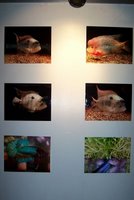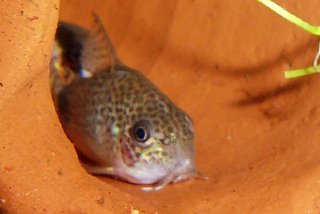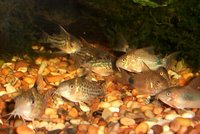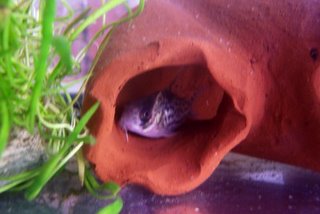Wednesday, December 14, 2005
More Eggs In the Cube
There are a few more eggs from the paleatus tank today and two from the panda tank last night. That pushes my egg count to 63. Today is day two for the first batch of eggs.
Betta Fry
Robin "imposed" two pairs of bettas on me for breeding. Since he figured I had nothing much to do with my free time. (Nevermind the waterchanges for one 42gal tank, five 15gal tanks, two 20gal tanks, one five gallon tank, seven 2.5gal tanks, and not counting the hospital tank and a couple of one gallon tanks.) Anyway, the first pair didn't yield a successful spawn. But the pair I put in last friday did. I took out the female sunday night when I noticed tiny black dots on the surface thinking they were fertile eggs. There was no bubblenest by the way so I thought it was a bust. But come monday morning, I saw very tiny fry swimming about near the surface. I started feeding them eggyolk which I did thrice a day. I kept the father in the tank to find out how he'd raise the fry as how male bettas normally would in the wild. I'd see him gather fry in his mouth when I drop food in the tank. I'm going on faith here that he ain't eating them. I'm planning three simultaneous spawns next and I'm thinking of separating the father just to see how that goes as well. Hopefully when I get the hang of this I'd be able to breed the bettas like clockwork.
Tuesday, December 13, 2005
Panda Fry
Yesterday, I decided to overhaul the 15gal breeding tank that housed 8 C. Pandas. The plan was to transfer the 8 pandas to the 20gal that housed the 5 other c. pandas, rid the 15gal of snails and move in a trilineatus breeding set there. But while I was pulling out the plants from the 15gal, I noticed about 5 tiny panda fry about three weeks old dashing about the tank. It was a pleasant surprise considering I never saw eggs being laid in that tank. After a long debate with myself, I decided to put back the breeding set in the 15gal. They seem to multiply pretty well there on their own. I didn't want to mess up their little community.
Later on, I saw a tiny transparent shrimp in the tank where I put the plants temporarily. Amazing what can trhive in an extablished tank.
Later on, I saw a tiny transparent shrimp in the tank where I put the plants temporarily. Amazing what can trhive in an extablished tank.
Paleatus Eggs
After noticing that my C. Paleatus have reached breeding stage, I moved them out of the home tank and into their own private tank. The tank was well planted with generous clumps of moss to hide the eggs. I was hoping to leave the eggs there but after realizing that the parents are able to locate the eggs afterall, I started pulling out the eggs with the help of an internet pre-paid card. I was able to take out about 54 eggs and at least 10 were left in places that I cannot possibly reach. I put the eggs in a small container with a drop of methylene blue and an air stone. Today is day one, since they were laid yesterday afternoon. I hope they make it.
Tuesday, December 06, 2005
Kiwi
My one and only baby panda is now foraging along with the adult cory's. Swimming with the big boys. I named him Kiwi. It's sort of our generic name for baby cory's because they are practically impossible to tell apart when many. His black markings are noticeably darker than the ones on my other pandas which I suspect is due to too much inbreeding. Kiwi must have been born from two different lines.
Tuesday, November 29, 2005
The Spotted Cory's Dilemma
 Having a bit of a pickle with the PC. It zonked out on me a week ago and as consolation, I treated myself to a trip to Cartimar last Wednesday, November 23, 2005. Stinky as hell but the shopping arcade is Manila's pet central selling all sorts of pets and supplies. Metro petshop has new stocks of c. schwartzi. They are selling for 230 pesos each which was cheaper than how much they were selling before at 350 per. They had good specimens, very healthy looking and shiny at the scales. At closer scrutiny though I've noticed that some of them had black spots on the dorsal fin that extended briefly at the top part of the body. It is a negligible detail except when you know that another species answer to this description-- the c. leucomelas. Leucomelas look very much like C. schwartzi except where the schwartzi has a white to translucent dorsal fin with some sprinkling of black dots, the leucomelas has a very distinctive black spot on the dorsal. Hence, the confusion. This lone spot on the dorsal fin is similar to that of the C. ambiacus, hence it is fairly possible that some c. ambiacus specimens can be mixed in with the schwartzi in the LFS. The schwartzi are now sold at 230 pesos compared to the 350 before. The leucomelas/ambiacus were sold at 90-100 pesos. I got one with the spotted dorsal. I figured, what ever name it answers to it is still a nice looking cory.
Having a bit of a pickle with the PC. It zonked out on me a week ago and as consolation, I treated myself to a trip to Cartimar last Wednesday, November 23, 2005. Stinky as hell but the shopping arcade is Manila's pet central selling all sorts of pets and supplies. Metro petshop has new stocks of c. schwartzi. They are selling for 230 pesos each which was cheaper than how much they were selling before at 350 per. They had good specimens, very healthy looking and shiny at the scales. At closer scrutiny though I've noticed that some of them had black spots on the dorsal fin that extended briefly at the top part of the body. It is a negligible detail except when you know that another species answer to this description-- the c. leucomelas. Leucomelas look very much like C. schwartzi except where the schwartzi has a white to translucent dorsal fin with some sprinkling of black dots, the leucomelas has a very distinctive black spot on the dorsal. Hence, the confusion. This lone spot on the dorsal fin is similar to that of the C. ambiacus, hence it is fairly possible that some c. ambiacus specimens can be mixed in with the schwartzi in the LFS. The schwartzi are now sold at 230 pesos compared to the 350 before. The leucomelas/ambiacus were sold at 90-100 pesos. I got one with the spotted dorsal. I figured, what ever name it answers to it is still a nice looking cory.For more info on identifying the spotted corydoras, check out this article: http://www.corycats.com/art%2002_the_spotted_ones.htm
Tuesday, November 22, 2005
Oh joy!
 I noticed a rustling underneath a clump of moss in the Sterbai breeding tank tonight. When I looked closer, there was a tiny panda cory about a centimeter in length scooting about in the muck. My very first baby cory! Before being an all sterbai breeding tank, it was a holding tank for both sterbai and panda. I guess the pandas spawned there when nobody's looking.
I noticed a rustling underneath a clump of moss in the Sterbai breeding tank tonight. When I looked closer, there was a tiny panda cory about a centimeter in length scooting about in the muck. My very first baby cory! Before being an all sterbai breeding tank, it was a holding tank for both sterbai and panda. I guess the pandas spawned there when nobody's looking.Earlier spawns resulted in fungused eggs or dead fry. Maybe now that the tanks are well established, I'd have more success breeding them. Keeping my fingers crossed.
Monday, November 21, 2005
New Cory's Weekend
 Yesterday morning. The C. Paleatus thought it was a good day to lay eggs...
Yesterday morning. The C. Paleatus thought it was a good day to lay eggs...Then that same Sunday afternoon, I got a bunch of new acquisitions for my cory collection-- C. Arcuatus, C. Haraldschultzi, C. Sodalis, some more C. Similis and more C. Trilineatus (but these ones are huge!). The Arcuatus I got from Exotic Fish Exchange and the rest from Exotic Acquatics. Very gracious people to deal with. Thanks, guys!
... and that night, the C. Paleatus thought it was a good night to eat eggs.
Thursday, November 17, 2005
Once Upon a Fish Show
The recent fish show in Glorietta did not have a catfish category.

 So just for kicks, I thought I'd enter two of my favorite corydoras shots in the photo contest. Pictures of a pair of corydoras trilineatus.
So just for kicks, I thought I'd enter two of my favorite corydoras shots in the photo contest. Pictures of a pair of corydoras trilineatus.I threw in a picture of my plakat betta (which I happened to have developed along with the cory shots) when I found out that there was no limit as to how many entries one can have in the contest.
Tuesday, November 15, 2005
Panda Cory Egg
Bad Tankmate for Corys

Was at the LFS the other day and I saw a lone croaking gourami in the cory tank. I saw it stalk and thereafter eat the eyes out of a juvy albino cory and after a closer look, I realized that most of the cory's there had fin damage of varying degrees. I bought the gourami but not without telling the salesperson never to keep a croaking gourami with corys.
The next day, there was a skunk botia there where the gourami has been. As you can imagine, it caused double the trouble that the gourami did. There was in fact one bronze cory dead there already. Changing my tactic, I didn't buy the botia and instead told a salesperson that they should never keep a botia with the cory's, pointing at the dead bronze cory for emphasis. Misinformed or just plain cruel, some LFS can be bad news for the fish as much as unconcerned fish buyers can be.
Saturday, November 12, 2005
Cory's Feeding
 Feeding time-- the highlight of my fishies' aquarium life...
Feeding time-- the highlight of my fishies' aquarium life...Corydoras are hearty eaters, making feeding time truly a sight to see. I feed them OSI Shrimp Pellets, Hikari Sinking Wafers, and occasional frozen bloodworms. I used to feed them Tetra Bits when I could not find any Hikari sinking wafers and I noticed enhanced red tone coloration among the Corydoras caudimaculatus.
Monday, November 07, 2005
Cory Tanks
Saturday, November 05, 2005
Fairy Catfish

C. Atropersonatus is the scientific name of the Fairy Catfish. I would LOVE to have this stunningly beautiful cory in my tank. Unfortunately, I have not seen this particular cory anywhere.
(My thanks to Dennis Wang's Corydoras for this pic-- http://denniswang.smugmug.com/Dennis%20Wang)
Friday, November 04, 2005
My C. Paleatus Breeding

I saw my peppered corydoras breed in the home tank this morning for the first time since I got them. They laid two to three eggs at a time. It was pretty cool to watch. I put a few drops of methylene blue in the tank and did not bother to take out the eggs since all the breeding tanks are occupied. So I am not really surprised that I could not find any of the eggs after I scanned the tank tonight. I just hope some of the eggs hidden in the plants survived. It would be fun to see some fry pop out of nowhere after a month.
Breeding Cory's in a Nutshell
 To breed cory's successfully, you must have two males per one female. A big water change (about 50%) with slightly lower temperature usually triggers breeding among cory's. When they are ready to breed, the males will chase the female around. After the female has chosen a male, they will get into a T-position in order for the female to gather milt from the male. The egg is dropped and caught in the female's pelvic fins drawn together making a pouch. She will then run away from the male and hide the eggs as best she can-- Cory's have a tendency to eat their own eggs.
To breed cory's successfully, you must have two males per one female. A big water change (about 50%) with slightly lower temperature usually triggers breeding among cory's. When they are ready to breed, the males will chase the female around. After the female has chosen a male, they will get into a T-position in order for the female to gather milt from the male. The egg is dropped and caught in the female's pelvic fins drawn together making a pouch. She will then run away from the male and hide the eggs as best she can-- Cory's have a tendency to eat their own eggs.
Thursday, November 03, 2005
Corydoras Ambiacus?
 These spotted cory's were labeled "Leucomelas" in the LFS (Metro Pet Center). But they look more like Ambiacus or Agassizi. So far, I am leaning towards Ambiacus (Anybody correct me if I'm wrong). There are even some specimens there that have spot patterns and body shape completely different from the one in the picture-- more like a schwartzi but with a spot on its dorsal fin.
These spotted cory's were labeled "Leucomelas" in the LFS (Metro Pet Center). But they look more like Ambiacus or Agassizi. So far, I am leaning towards Ambiacus (Anybody correct me if I'm wrong). There are even some specimens there that have spot patterns and body shape completely different from the one in the picture-- more like a schwartzi but with a spot on its dorsal fin.Php 90 for the smaller ones and Php 110 for the big ones. And I do mean big (in cory terms)-- 2.5in (length) x 1.5in (height). I got only the smaller ones thinking they might grow bigger but if somebody would offer me a big specimen (esp. somebody who purchased it from the same batch I got mine) right now, I'd take it. I forgot that female corys are generally bigger than males. They are out of stock as of this writing. And as with the rest of these sporadically available corys, I have no idea when they will be available again, if at all.
Corydoras Schwartzi
Corydoras Similis
Corydoras Elegans
 Also known as the Elegant Cory, C. Elegans is a slender cory. Quite different from most other cory's that are rather stocky in build. Unfortunately, I have not seen these cory's in any LFS I frequent. I got mine from a wholesaler so I had to buy more than I normally do. Fortunately, they were not as expensive as the Caudi.
Also known as the Elegant Cory, C. Elegans is a slender cory. Quite different from most other cory's that are rather stocky in build. Unfortunately, I have not seen these cory's in any LFS I frequent. I got mine from a wholesaler so I had to buy more than I normally do. Fortunately, they were not as expensive as the Caudi.Corydoras Caudimaculatus

The Corydoras Caudimaculatus sort of got me back into keeping cory's. At Php 720 (US$ 13) they were not cheap. But they were extremely cute and I was not able to resist buying a few of them. Their availability locally would be what I'd call rare. Going around the LFS has been a hobby of mine for at least a decade now and that was the first time I ever saw the Caudi in a local store.
Corydoras Trilineatus
Wednesday, November 02, 2005
The Commonly Available Cory's
I'm Not a Pundit
 I will not talk Philippine politics (i.e. Cory here does not mean our first woman president, but a fish). This is actually a journal informally documenting my search for corydoradinae catfish in the local fish scene. These dimunitive, South American catfish are relatively rare in this country so the search is not easy. Finding new additions to my collection therefore is like finding hidden treasure.
I will not talk Philippine politics (i.e. Cory here does not mean our first woman president, but a fish). This is actually a journal informally documenting my search for corydoradinae catfish in the local fish scene. These dimunitive, South American catfish are relatively rare in this country so the search is not easy. Finding new additions to my collection therefore is like finding hidden treasure.P.S.: My little bronze cory says hello.
Subscribe to:
Posts (Atom)











